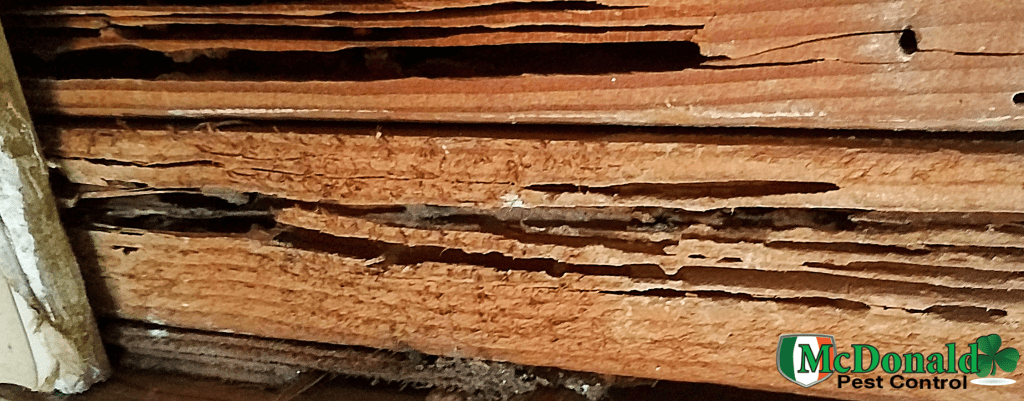Termite damage on wood can be hard to spot at first. These tiny pests can cause serious harm if left untreated.
Wood is a common target for termites. They chew through it, making it weak and hollow. This can lead to big problems in your home. If you notice small holes, cracked paint, or wood that sounds hollow, you might have termites.
Spotting these signs early can save you from costly repairs. Termites work quietly, often inside walls or under floors. Knowing what to look for can help you act fast. This guide will show you the key signs of termite damage on wood. Stay informed and protect your home from these destructive pests.
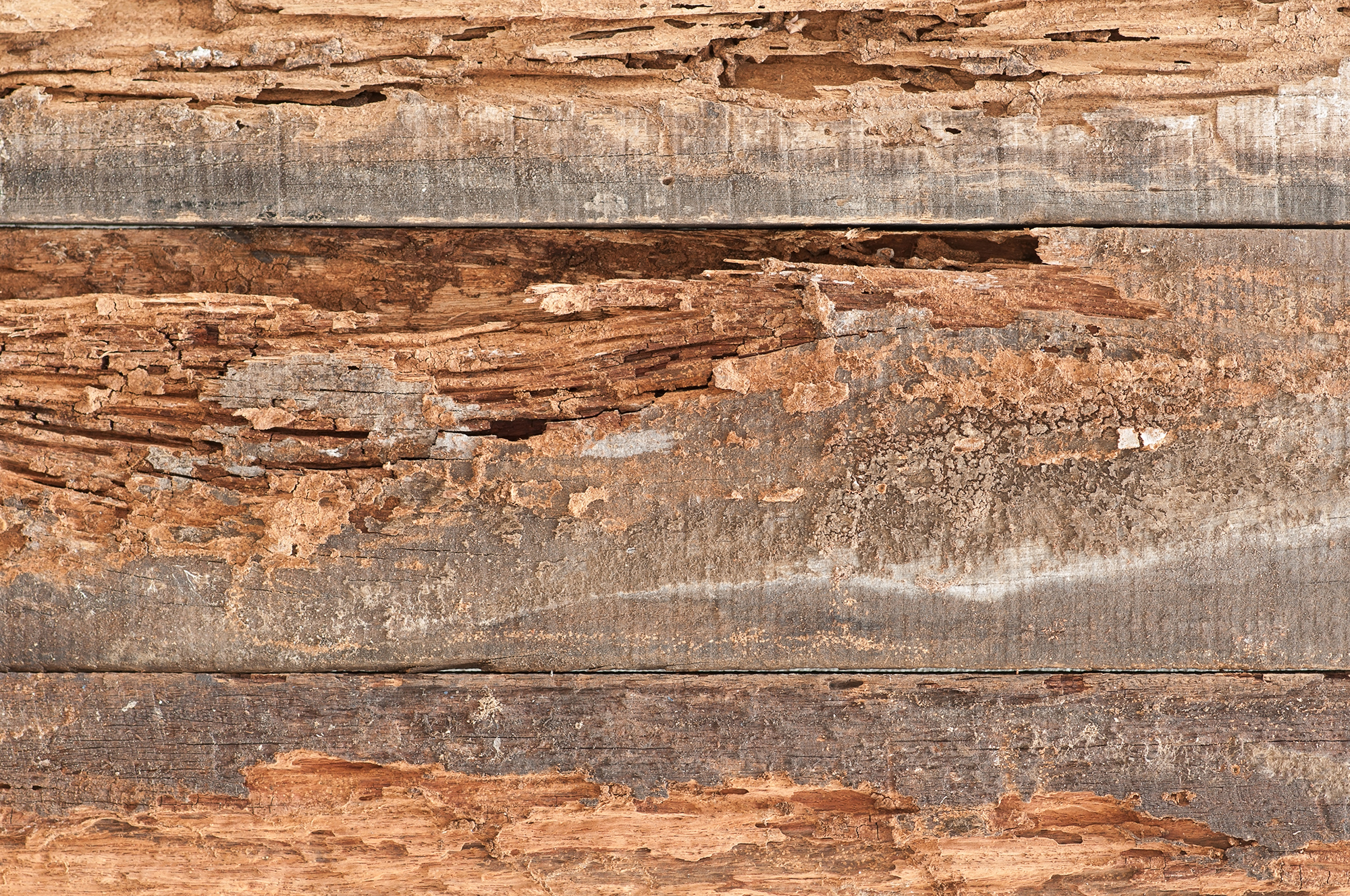
Credit: www.smartextpros.com
Introduction To Termite Damage
Termite damage on wood often appears as hollowed-out sections, with tunnels and grooves. You might notice crumbly or damaged wood surfaces.
Hey friends, today we’re diving into a topic that’s pretty important if you own a home or any wooden structure. We’re talking about termite damage. It’s something that can sneak up on you, and before you know it, your beautiful wooden furniture or even the structure of your house could be in trouble.
When termites get into your wood, they can cause a lot of harm. The wood may look like it’s been chewed up. You might see small holes, or it could even sound hollow when you tap on it. But don’t worry, by the end of this, you’ll know what to look for and how to spot the signs early.
Why Termites Target Wood
Termites love wood. But why? Well, wood has cellulose, which is what termites eat. Think of it like a buffet for them. They munch on it to get the nutrients they need.
– Cellulose: Found in wood, it is a major part of a termite’s diet.
– Shelter: Wood provides a safe home for termites to live and breed.
– Moisture: Damp wood is even more attractive to termites as it is easier for them to chew.
They are like tiny, silent destroyers. You won’t even hear them as they work away at the wood in your home.
Common Types Of Termites
Not all termites are the same. Here are a few types you might come across:
1. Subterranean Termites:
– These termites live in the ground.
– They build mud tubes to reach wood above ground.
– They are the most common and the most destructive.
2. Drywood Termites:
– They live inside the wood they eat.
– They do not need soil contact.
– They are usually found in furniture or wooden walls.
3. Dampwood Termites:
– They prefer wood with high moisture content.
– Often found in wet or decaying wood.
– Less common but still damaging.
Knowing these types can help you understand where to look and what to expect.
So, the next time you see wood that looks a bit off or find tiny holes, you might have a termite problem. And knowing what to look for is the first step in fixing it. Stay tuned for more tips on how to protect your home from these little pests!
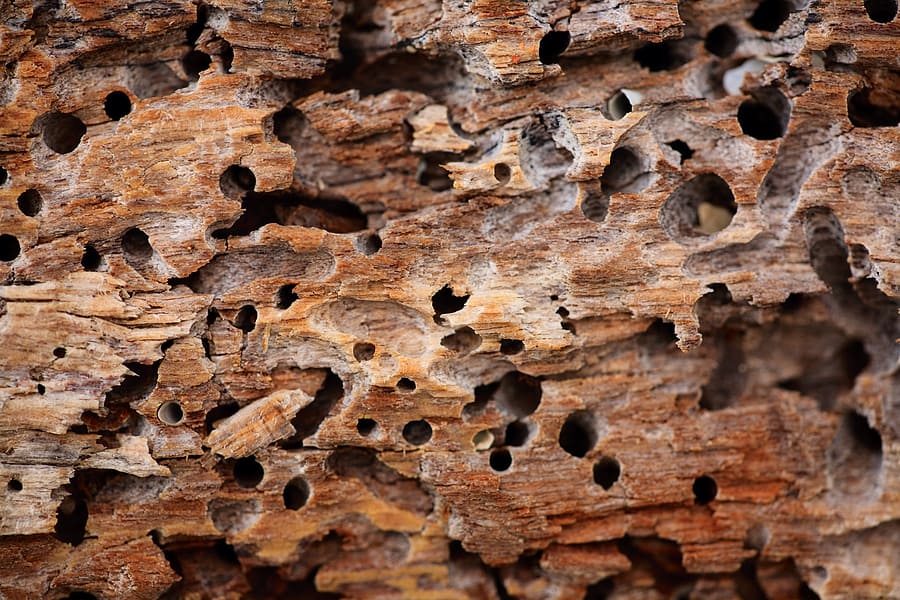
Credit: www.callnorthwest.com
Early Signs Of Termite Infestation
Hey friends, today we are talking about something that can save your home from serious damage: the early signs of termite infestation. Termites are sneaky little pests that can cause big problems. Catching them early can save you a lot of money and trouble. Let’s dive into the signs you should look for.
Mud Tubes
Termites build mud tubes to travel from their nest to their food source. These tubes look like small tunnels made of soil and wood particles. You might find them on your walls, foundation, or even in crawl spaces. They protect termites from the light and keep them moist, which they need to survive.
Here’s what to look for:
- Tubes about the width of a pencil
- Clusters of these tubes in one area
- Break a tube open and look for creamy white insects inside
If you see these signs, it’s time to call a professional. Trust me, I once ignored a small mud tube, and it turned into a big problem later!
Discarded Wings
Another sign of termites is discarded wings. When termites swarm, they fly to find a new home. Once they land, they shed their wings. These wings are small, clear, and can often be found near windows, doors, or light sources.
Here’s what to check for:
- Small, clear wings on windowsills or floors
- Wings that are all the same size (unlike ant wings)
- Clusters of wings in one spot
Finding these wings is a sign that termites are looking to set up a new colony in your home. Don’t ignore it. I found a pile of wings near my back door once and called an exterminator right away. It saved me a lot of hassle.
In conclusion, keeping an eye out for mud tubes and discarded wings can help you catch a termite problem early. It’s simple, but it can make a big difference. Stay alert and protect your home!
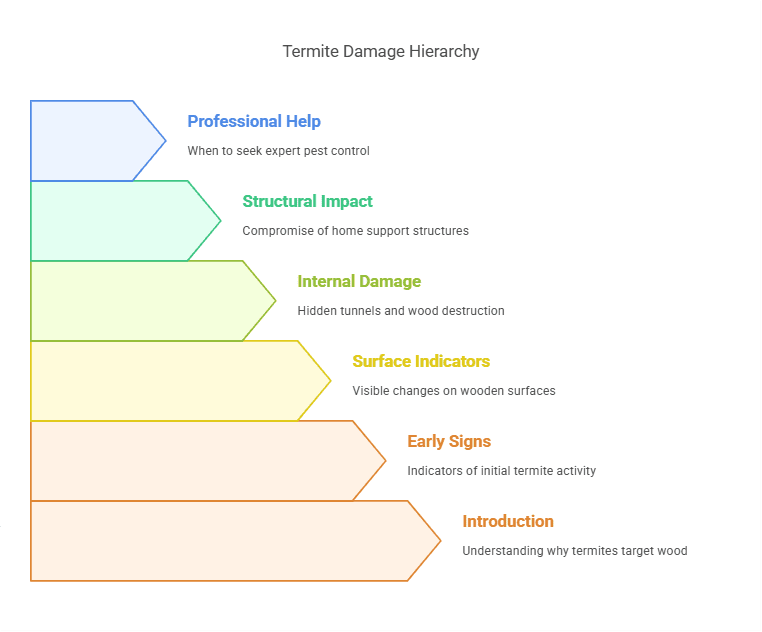
Surface Indicators On Wood
Hey there, curious minds! Termite damage can be a real nightmare, especially if you love your wooden furniture and house. But don’t worry, we’re here to help you spot the signs early. In this section, we will talk about the surface indicators on wood. These are the first clues that termites might be causing trouble under the surface. Let’s dive in!
Bubbling Or Uneven Paint
One of the first things you might notice is bubbling or uneven paint. It’s like when you overcook a pancake and it gets those weird bubbles. That’s a sign something’s off underneath. Here’s what to look for:
- Paint that looks like it’s lifting off the wood
- Uneven surfaces that feel bumpy to the touch
- Paint that cracks or peels away easily
Why does this happen? Termites create tiny tunnels inside the wood. These tunnels make the surface uneven, and that causes the paint to bubble or crack. So, if you see bubbling paint, don’t ignore it. It could be termites!
Hollow-sounding Wood
Another sign to watch out for is hollow-sounding wood. Imagine knocking on a door that sounds solid. Now, imagine knocking on a door that sounds empty. That’s the difference termites can make. Here’s how to check:
- Tap on wooden surfaces with a screwdriver or your knuckles
- Listen for a hollow or empty sound
- If it sounds hollow, you might have a termite problem
Termites eat the wood from the inside out. So, even if the surface looks okay, the inside might be hollow. It’s like a chocolate Easter bunny—looks solid, but it’s empty inside. If you hear that hollow sound, it’s time to call a professional.
So there you have it, friends. Bubbling paint and hollow wood are two big surface indicators of termite damage. Keep an eye out for these signs. Catching them early can save you a lot of trouble and money. Stay alert and protect your wood!
Internal Wood Damage
Termite damage can be devastating, especially when it affects the internal structure of wood. These tiny pests burrow deep into wooden beams, furniture, and other wooden structures. This often leaves behind significant damage that is not immediately visible.
Tunnels And Galleries
Termites create extensive networks of tunnels inside the wood. These tunnels, also known as galleries, can weaken the structure. They can run in various directions, making the wood resemble a honeycomb. You might notice the wood sounds hollow when tapped. This is a clear sign of internal termite damage.
Wood Shavings And Frass
Another indicator of termite damage is the presence of wood shavings. These shavings are often found near the affected wood. Termites also produce frass, which is a type of wood dust or pellets. Frass resembles sawdust and can accumulate around the damaged areas. These signs are crucial for identifying termite activity inside the wood.
Structural Damage To Homes
Termite damage on wood appears as hollowed-out sections, often with a maze-like pattern. You may notice buckling wood and small holes.
Termite damage can be devastating to a home. These tiny pests eat through wood, causing significant structural issues. Recognizing the signs early can save you from costly repairs. This section will help you understand what termite damage looks like on wood, focusing on structural damage.
Weakening Of Support Beams
Support beams are essential for a home’s stability. Termites can weaken these beams by hollowing them out. You might notice a honeycomb pattern inside the wood. This pattern indicates termite activity. Over time, the beams lose their strength. They can no longer support the weight they were designed to hold. This weakening can lead to dangerous consequences.
Sagging Floors And Ceilings
Termites can also damage floors and ceilings. They eat through the wooden structures that keep these surfaces level. You might notice sagging or uneven floors. Ceilings may also start to droop. This sagging is a clear sign of termite damage. Floors may feel spongy or soft when you walk on them. Ceilings may show visible cracks or dips. Both issues signal serious structural problems.
Act quickly if you see any of these signs. Early detection can prevent further damage. Regular inspections can help keep your home safe from termites.
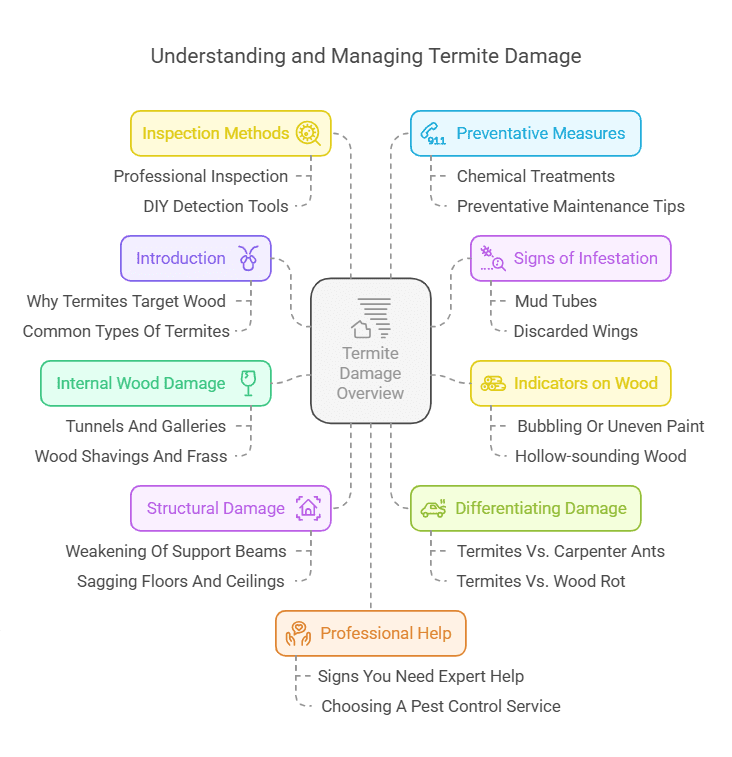
Differentiating Termite Damage From Other Pests
Termite damage on wood is often mistaken for damage caused by other pests or factors. Differentiating between these can help in treating the problem correctly. This section will guide you in identifying termite damage compared to other common wood issues.
Termites Vs. Carpenter Ants
Carpenter ants and termites both damage wood, but they do it differently. Carpenter ants create smooth, clean tunnels. These tunnels look like they are sanded. Termites, on the other hand, eat the wood. Their tunnels are rough and filled with dirt.
Termite tunnels often have a muddy appearance. This is due to the soil and saliva they use. Carpenter ants do not eat wood. They remove it to create their nests. Their tunnels are more organized. Termite damage often appears more chaotic and messy.
Termites Vs. Wood Rot
Wood rot occurs when wood gets wet and begins to decay. This can be mistaken for termite damage. Rotted wood is usually soft and crumbly. Termite-damaged wood often looks similar but has different features.
Termite-damaged wood will have a honeycomb pattern inside. This is due to the termites eating through it. Wood rot does not have this pattern. Rotted wood will break apart easily. Termite damage, while messy, may still hold some structure.
Recognizing these differences can help you identify the problem. This ensures the right treatment is applied to save your wood structures.
Inspection And Detection Methods
Termite damage on wood can be subtle or severe. Detecting it early is crucial to prevent extensive damage. There are various methods for inspecting and detecting termite damage. Some methods require professional help. Others you can do yourself with the right tools.
Professional Inspection
Hiring a professional inspector ensures a thorough check. Experts know where termites hide. They use special equipment to detect termites. Moisture meters and infrared cameras can identify hidden colonies. Professionals also have the experience to spot signs that others might miss.
Diy Detection Tools
There are tools you can use at home. Flashlights help spot visible damage. A screwdriver can probe wood for weakness. Listen for hollow sounds when tapping wood. Termite droppings look like small pellets. Check for mud tubes on wooden structures. These are common indicators of termite activity.
Preventative Measures And Treatments
Hey friends, today we’re diving into how to protect your home from termite damage. Termites can cause serious harm to wooden structures, but don’t worry, there are ways to prevent and treat this. Let’s explore some effective steps you can take to keep your wood safe from these pesky invaders.
Chemical Treatments
One of the most common ways to protect your home from termites is through chemical treatments. These treatments can either be applied directly to the wood or around your home’s perimeter. Here’s a quick rundown of how these treatments work:
- Liquid Soil Treatments: These are applied to the soil around your home. They create a barrier that kills termites when they come into contact with it.
- Wood Treatments: These involve applying chemicals directly to the wood. This can prevent termites from eating it and stop any existing infestations.
- Bait Stations: These are placed around your home and contain a chemical that termites carry back to their colony, effectively killing the entire nest.
Chemical treatments can be very effective, but it’s important to follow the instructions carefully. Sometimes, it might be best to consult with a professional to ensure you’re using the right products and methods.
Preventative Maintenance Tips
In addition to chemical treatments, there are some simple maintenance tips you can follow to keep termites at bay. These tips are easy to implement and can make a big difference. Think of it like regular check-ups for your home.
- Keep Wood Dry: Termites love moisture. Make sure there’s no standing water around your home, and fix any leaks immediately.
- Store Firewood Properly: Keep firewood and other wooden materials away from your home. Store them off the ground and cover them to protect from moisture.
- Seal Cracks and Gaps: Inspect your home for any cracks or gaps, especially around windows and doors. Seal them to prevent termites from getting in.
- Regular Inspections: Have a professional inspect your home regularly for signs of termites. Early detection can save you a lot of trouble.
Taking these simple steps can greatly reduce the risk of termite damage. A little effort now can save you from a big headache later.
I recently asked a pest control expert about the best ways to prevent termite damage, and they emphasized the importance of both chemical treatments and regular maintenance. They told me a story about a homeowner who ignored a small leak under their kitchen sink. A few months later, they discovered extensive termite damage that could have been prevented with a quick fix. The lesson? Don’t ignore small issues. They can lead to big problems.
So, friends, keep an eye out for those little signs and take action quickly. Your home will thank you!
When To Call A Professional
Signs of termite damage on wood include hollow-sounding wood, visible tunnels, and crumbling structures. Call a professional if you see these.
Termite damage can be sneaky. Often, the signs are hidden. You may not notice until it’s too late. Knowing when to call a professional is crucial.
Signs You Need Expert Help
You might see hollow-sounding wood. This is a red flag. Another sign is damaged wood that looks like it’s been eaten. If you see discarded wings, termites are nearby. Mud tubes are also a sign. They use these tubes to travel. Sometimes, you’ll notice swollen floors or ceilings. That means termites have done severe damage.
Choosing A Pest Control Service
Start by researching local companies. Look at reviews and ratings. Find a service with experience in termite control. Make sure they have proper licenses. Ask about their methods. Some use chemicals; others prefer heat treatments. Get quotes from multiple services. Compare costs and services. Ensure they offer a follow-up plan. This helps prevent future infestations.

Credit: www.chemfreeexterminating.com
Frequently Asked Questions
How Do You Know If Wood Has Termite Damage?
Check for hollow-sounding wood, visible tunnels, frass (termite droppings), buckling paint, and discarded wings near damaged areas.
How To Tell The Difference Between Carpenter Ant Damage And Termite Damage?
Carpenter ant damage shows smooth, clean galleries, while termite damage has rough, mud-filled tunnels. Termites eat wood; ants don’t.
Can You Live In A House With Termite Damage?
Yes, you can live in a house with termite damage. However, it’s crucial to address the damage and treat the infestation promptly to ensure safety and prevent further destruction. Regular inspections and professional help are essential.
What Does Early Termite Damage Look Like?
Early termite damage appears as small holes in wood, discolored drywall, peeling paint, and hollow-sounding wood. It may also show mud tubes.
Conclusion
Termite damage can seriously harm wood structures in your home. Look for hollowed wood, tiny holes, and sawdust-like droppings. Early detection helps prevent bigger issues. Regular inspections keep your home safe from these pests. Remember, maintaining a termite-free home protects your investment.
Always stay alert for signs of termite activity. Use professional help if needed. Stay informed, stay safe.

